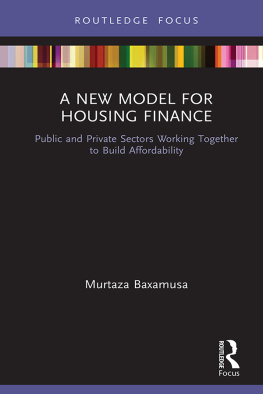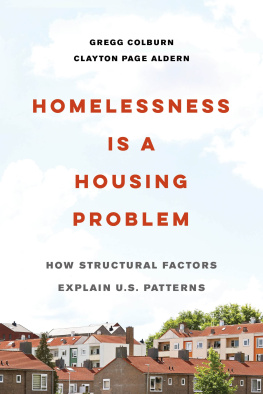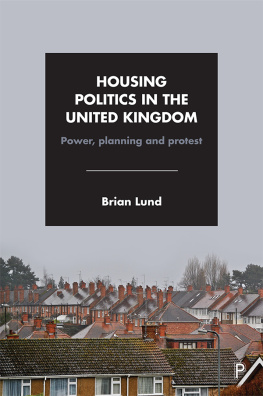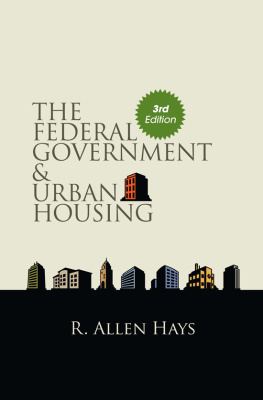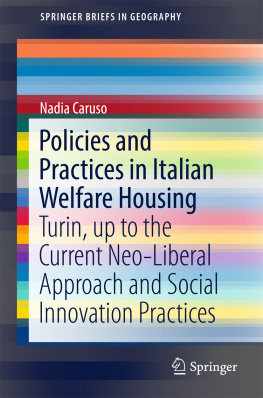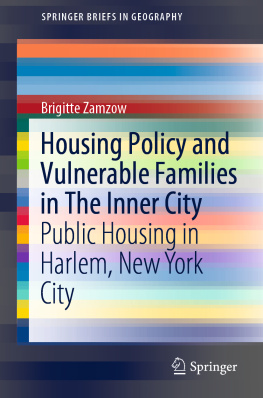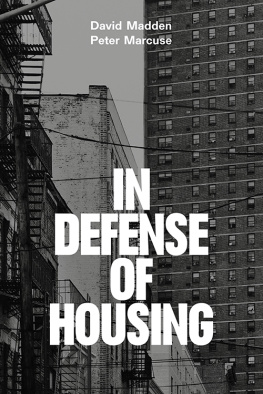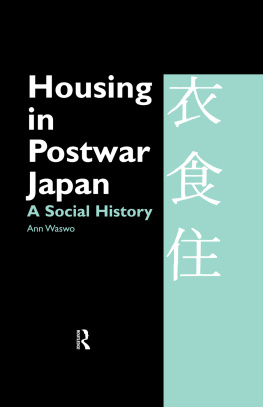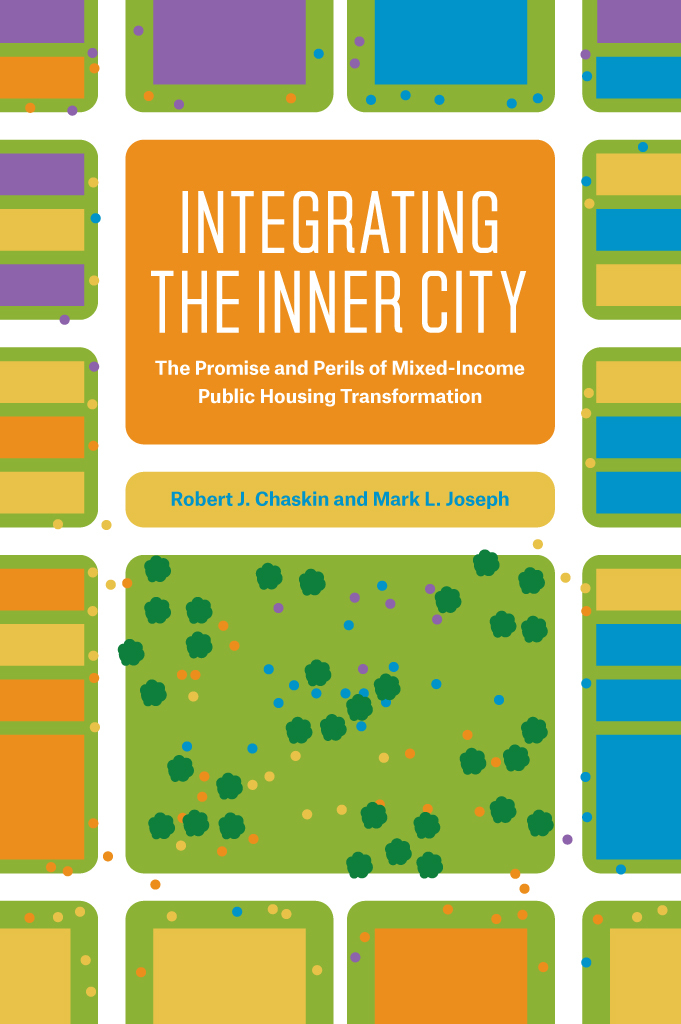Integrating the Inner City
The Promise and Perils of Mixed-Income Public Housing Transformation
Robert J. Chaskin and Mark L. Joseph
The University of Chicago Press
Chicago and London
ROBERT J. CHASKIN is associate professor and deputy dean at the University of Chicago School of Social Service Administration and director of the University of Chicago Urban Network.
MARK L. JOSEPH is associate professor in the Jack, Joseph and Morton Mandel School of Applied Social Sciences at Case Western University and director of the National Initiative on Mixed-Income Communities.
The University of Chicago Press, Chicago 60637
The University of Chicago Press, Ltd., London
2015 by The University of Chicago
All rights reserved. Published 2015.
Printed in the United States of America
24 23 22 21 20 19 18 17 16 15 1 2 3 4 5
ISBN-13: 978-0-226-16439-7 (cloth)
ISBN-13: 978-0-226-30390-1 (e-book)
DOI: 10.7208/chicago/9780226303901.001.0001
Library of Congress Cataloging-in-Publication Data
Chaskin, Robert J., author.
Integrating the inner city: the promise and perils of mixed-income public housing transformation / Robert J. Chaskin and Mark L. Joseph.
pages; cm
Includes bibliographical references and index.
ISBN 978-0-226-16439-7 (cloth: alk. paper)ISBN 978-0-226-30390-1 (e-book) 1. Mixed-income housingIllinoisChicago. 2. Inclusionary housing programsIllinoisChicago. 3. Community developmentIllinoisChicago. 4. Social integrationIllinoisChicago. 5. Chicago Housing Authority. Plan for Transformation. I. Joseph, Mark L., author. II. Title.
HT177.C4C43 2015
307.3'4160977311dc23
2015014463
This paper meets the requirements of ANSI/NISO Z39.48-1992 (Permanence of Paper).
We dedicate this book to Harold Richman, our beloved and dearly missed mentor who brought the two of us together over twenty years ago and whose commitment to social change continues to inspire our work.
Contents
Public housing in the United States has been in significant decline over the past several decades, contributing in many citiesperhaps most dramatically in Chicagoto racially segregated neighborhoods of highly concentrated poverty, crime, and physical deterioration. In an effort to respond to these circumstances and counter the negative impact of concentrated poverty on the populations in these neighborhoods, both federal policy and local policy have rethought public housing. Policy responses have included providing vouchers to help families in public housing move to less disadvantaged neighborhoods as well as launching ambitious redevelopment efforts to renovate or, in the most severe cases, rebuild public housing complexes. The new developments replacing distressed public housing are designed as mixed-income communities, providing homes for public housing residents and other low-income renters alongside more afuent renters and homeowners, and in some cases including residents of different racial and ethnic backgrounds. Many of these efforts have led to dramatic changes in the built environment, but they have also generated a great deal of controversy and significant social tension.
The Chicago Plan for Transformation, launched in 2000, is the largest-scale mixed-income public housing redevelopment in the United States. Like other efforts of its kind, the Plan for Transformation seeks to respond to concentrated urban poverty and the dramatic deficiencies of public housing by removing residents from failing public housing complexes and remaking these complexes into new mixed-income communities. At the center of the Transformation is an emphasis on integration. As the Chicago Housing Authority clearly states, the intent is to build and strengthen communities by integrating public housing and its leaseholders into the larger social, economic and physical fabric of Chicago. The mixed-income developments replacing public housing complexes represent the Plans most concerted effort to realize these integrationist goals and to remake the inner city.
Before exploring in depth the ideas, actors, and actions that lie behind this effort and how it is playing out, in these opening pages we offer a window into the social dynamics that characterize these new communities and that to a large extent condition how fully the integrationist goals of the Transformation are likely to be met. Drawn from focus groups with residents living in one of the new mixed-income developments replacing public housing complexes in Chicago, these conversations provide an introduction to residents experiences in these communities and their outlook on this bold social experiment to end the segregation of the poor in public housing.
Note that the focus on integration is primarily driven by ideas about the benefits of economic and social integration. Racial integration is not an explicit goal, though race plays into the dynamics to be explored in important, if sometimes complicated, ways. Virtually all public housing residents in Chicago are African American, as are virtually all renterssubsidized and market-ratein the new mixed-income communities that are the focus of our study. Homeowners are a more diverse group in these contexts, but the extent of racial and ethnic diversity differs from site to site.
What follow are excerpts from two conversations at the same development, one among a group of relocated public housing residents and the other among a group of homeowners. The discussions illustrate some of the central challenges that have emerged and that we will explore further in the chapters to follow.
Minimal Social Interaction: Its Just Like Youre Invisible
For many relocated public housing residents, the benefits of living in brand-new apartments in safer, revitalizing neighborhoods are offset by the downside of feeling stigmatized and marginalized by their new, more afuent neighbors. Any hopes that residential proximity would bridge differences and build personal networks that might promote access to opportunity are being dashed by the reality of enduring social distance and exclusion.
Sarah: [Y]oure trying to interact. But its just like youre invisible. Nobody dont want to recognize you.
[...]
Sarah: Say, like you are getting on the elevator. People are coming off the elevator. You speak... you just say good morning, good afternoon. People walk right past you... like youre not even there. So when it happens two or three times... you wasted all this good breath just being nice.
Evelyn: Theres mighty few of them that will say hello or Could I help you do something? Or Im coming in with bags or groceries and they would ask me, Could I help you? These are students [who might engage], but the grown people look at you just like youre trash. And I have bills, and pay rent and everything else just like they do, even though Im up under CHA, but Im still the same person. I think of myself just as good as you or maybe better.
A Clash of Cultures: Why the Heck You Banging on That Door This Late?
For many, if not all, homeowners, the benefits of living in handsomely designed condos and townhomes conveniently located just a few minutes drive from downtown and within walking distance of amenities like lakefront access are offset by disappointment in the prevailing social atmosphere. What they describe as ghetto behavior and mentality plays out in a range of perceived incivilities and transgressions, from hanging out to littering to inconsiderate, noisy disturbances. These perspectives are broadly representative of the homeowners we spoke with, regardless of race or ethnicity. The homeowners participating in this focus group are all African American.


